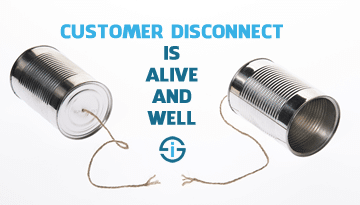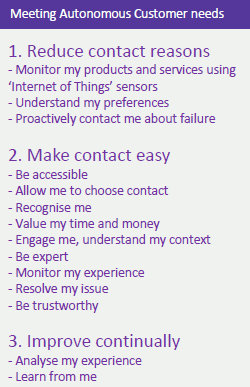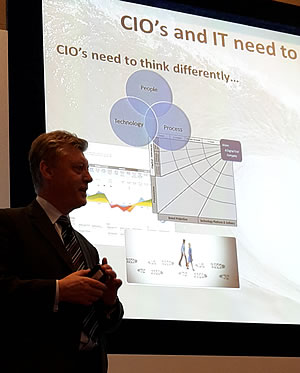 For many (really many) years now we’ve been talking about the disconnect with the customer. And the need to reconnect with the customer as the effects of a perfect storm – that’s been in the make for decades – started being felt.
For many (really many) years now we’ve been talking about the disconnect with the customer. And the need to reconnect with the customer as the effects of a perfect storm – that’s been in the make for decades – started being felt.
The disconnect between what we believe as businesses to be valuable for customers and what customers – people – see as valuable. The signs, research and impact are known since so long. Just take the famous customer experience delivery gap I mentioned here.
Reconnecting? Start with the essence
To thrive – let alone survive – (in) this perfect storm (and it isn’t over yet) we wanted to become more ‘conversational’ (from monologue to dialogue) and customer-centric. We wanted to understand our customers better. In order to make better products, to offer better services and to improve the ways in which we communicate: to reconnect in all possible ways.

The question we now increasingly see popping up is if customers, consumers, want us to reconnect with them at all. And – we are all consumers – deep down we know the answer more often than not is a simple “no”. We start realizing it. And as we see the rise of this “digitally” empowered and as a report by BT and Avaya calls it “autonomous” customer who really wants to call the shots, we try to go further.
We focus on the essence, on simplicity, on making the difference, on what really matters to customers. Simple has become the new mantra. Simple is the new black, the result of total focus on a consumer who doesn’t want relationships in many cases.
[blockquote] Simple is the new black, the result of utter focus on a consumer who doesn’t want relationships in most cases.[/blockquote]Customer service at the customer’s service
Also since many years we finally started to recognize the importance of customer service. Not just customer service in the strict sense but also as being at the customer’s service. We talk about relevance, experiences and start to look at the key role of emotions.
It’s not because we had an ‘aha’ moment, it’s because we were scared about the impact of customer service going wrong in an ever more digital, social and connected environment where the visibility of flaws is clearer and dissatisfied voices carry further than ever before.
On top of that, customers have changed. They lost patience, they lost trust, they saw the disconnects and they have become far more individualistic and demanding.
The call to see customer service departments and contact centers as core value creators instead of cost centers, with all the changes this requires, is not new but louder than ever. It is translated in the need to redefine customer service, the role of contact center agents, the need to move customer service higher in the organizational structure, the connecting of information silos, the shift towards customer experience and ‘simplicity’ metrics over often meaningless transactional metrics.
Again, it’s not just about customer service in the strict sense. Joseph Jaffe already made that clear in his Customer Service Manifesto five years ago.
Customer and customer experience: lip service?
And it’s not just in customer service. It’s everywhere. The clearly growing attention for the customer and customer experience across virtually all business functions indicates how we recognize something must change as we’ve been told for ages. The attention for digital transformation, which – as I often wrote before -in practice today is mainly revolving around people (customers, employees, users) and around the transformational needs regarding customer experience, shows it.
Unfortunately, we are still very much in the stage of paying lip service to all these customer-related evolutions and necessities, just as we are in the involvement of customers into the products, services and even content and messaging we develop and the innovations we bring in order to survive a very fast changing and challenging economy, that often is becoming a real-time economy.
As I wrote in the beginning: “we start to recognize the importance”. Yet, in practice many don’t and of those who do, many are clueless about how to tackle it in a smart and integrated way, step by step, from the lowest possible hanging fruit (optimization of what we have in the interactions and channels that are essential) to the levels of relevance and customer focus at the top of the proverbial funnel in marketing.
The challenge is in the boardroom: linking customer focus and profit/revenue
Common sense and experience tells us that – in most cases, there are exceptions – the shift towards a customer-centric operational model in line with our business goals requires 1) a thorough, integrated and genuine understanding of our customers and (their) broader ecosystems, 2) executive support and boardroom focus on the realization of this customer-centric approach and 3) going beyond dashboards, involving frontline employee and customer feedback to effectively change, act, do something that makes lives of customers easier or just more fun.
The big challenge we have – on top of all the work that needs to be done to get there, even if a step-by-step strategy can do miracles and it isn’t THAT hard – sits in the boardroom.
Many executives are still not understanding that there is an undeniable link between higher revenues/profits and putting the customer first. They still don’t see that customer satisfaction does matter and that there is even an amazing link between optimizing for the customer and reducing costs.
[blockquote author=”Jo Causon”]There are many leaders who adopt a customer-centric approach to business strategy, but all Boards need to have representatives who either have direct experience of customer service roles. If such a role doesn’t exist, they need to develop the skills, insight and vision to ensure that the customer is a constant reference point.[/blockquote]And that despite the fact that over and over in the past it became clear that any transformational, impactful and strategically smart exercise to look at the organization and all processes from a different customer-oriented perspective, leads to cost savings. Because it helps us see the fat, the wrong spending, the things that don’t work or pay off. And, more importantly because it is done from another perspective than that of the ivory towers in which too many executives and boards still live.
Looking at the organization in a different way
In particular I think about more or less far-reaching exercises revolving around data, measurement and analytics. Several years ago I wrote a few (Dutch) books. One of them was about Marketing ROI or Return On Marketing Investment (ROMI). A second one was about customer and web analytics. In other books and eBooks I talked about integrated marketing, content marketing (in the genuine holistic sense) and social business/media, again in a holistic sense (meaning: touching several business functions, operations and areas, not just marketing).
In all of them I stressed how doing all these things (for instance a step-by-step or full scale implementation of ROMI or looking at marketing and service from a customer-centric and integrated perspective) forced us to look at our organizations, often reorganize and certainly optimize.
This isn’t exactly rocket science. Especially where data, metrics, measurement and processes come into the picture (and is there an area where they don’t, optimization is an inevitable result when it’s properly done?). The same goes for exercises where the ways we conduct business and interact with customers have to be reviewed. That’s a big part of what social and integrated marketing, for instance, are all about.
Let me put it another one: ANY optimization effort by default is about people/customers and goes hand in hand with numbers, data and processes involving multiple divisions and stakeholders. And even further: optimizing for the customer is the same as optimizing for the business and the bottom-line and will always lead to cost efficiencies whereby the freed up resources can be used for things that make more sense and create more – mutual – value.
The reason why I talk about cost reduction and profit is because it’s the language that every executive and CxO understands. Far more than they understand the language of customer journeys, customer experience and whatnot. This doesn’t mean that there aren’t execs who DO understand that language too. Well on the contrary.
CIO, CMO, CxO: changing roles and narratives

Recently I was at an event (the AIIM Forum UK 2015) where the CIO of UK-based Severn Trent Water filled his keynote with employee and customer journeys. And he’s not the only one. I’m lucky enough to have worked where IT, marketing, technology and customers/people/psychology meet my whole career. And each CIO, information management professional or IT exec I met over the past year was very very busy with and knowledgeable about the things marketers often think they alone understand. There’s even quite a bit marketers can learn from information technology and management professionals. The opposite is true as well of course.
Yet, it’s clear that the roles are shifting and IT and business do grow towards each other. The CIO is getting his place in the boardroom. Slowly but surely. And the CMO is becoming digital and technology savvy. At least in the organizations that make the difference. It’s probably not a coincidence that in agencies the ‘creative’ role, business role and data/tech functions work closely aligned as well.
Despite all these evolutions and the advent of new roles (well, not that new) such as Chief Customer Officers, Chief Digital Officers etc. who are often especially useful in organizations where there is a lack of respectively genuine customer focus and true digital culture, the gaps however remain, also in the customer context.
The challenge to solve: the boardroom and CEO don’t care (enough)
The sad matter of the fact is that at the very top of the organization the disconnect with the customer is still huge. How else can you explain that according to ‘Leading by Example’, a recent report by The Institute of Customer Service, only 51% of employees and LOB managers think their CEO and Board are interested in customer insight and that less than 50% believe senior executives understand customer needs. At least as worrying: “only 36 percent of managers think their senior executives ‘actively listen’ to customers in an effort to improve service, whilst fewer than half (44 percent) of frontline staff also feel their ideas are taken on board”.

Sure, there is a difference between what employees and LOB execs think and what really happens but it’s not that big, trust me. In fact, looking at more data from the report I think it’s safe to say that most (in this case UK) CEOs and boards don’t care too much about what customers want, let alone what their frontline employees and other ‘sources’ hear each single day. As Jo Causon says: “If employees suggest that customer needs are not understood in the Boardroom, what must customers be feeling?”
I could go on mentioning data from the report but you can check it out yourself so let me conclude this part with a last quote: Half (51 percent) also believe Boardrooms ‘put profits before the delivery of a great customer experience’.
If we don’t see the link between profits and customer experience and overlook our front-line people as we overlook our customers, then how do we even start to convince our teams to work in a more customer-centric way? How can we promote customer-oriented metrics and reward mechanisms for staff if they know the CEO and board don’t really care? How can we optimize at all if ego, “position”, politics and the eternal focus on the short term (and there’s always an urgent reason for that short term) stand in the way of defending the importance of the customer and looking at it from a short term (low hanging fruit), medium term and long term perspective? The changing and more important role of customer service and contact centers? The need to invest in “relevance”? Complexity, fluff and fear aren’t excuses anymore.
Actions to take today
The answer to these questions is all the more important if we realize that the transformations needed to really put the customer – and people – first as a way to create value for the business require buy-in and involvement from the CEO and board.
It needs to be answered because if customer-centricity, customer service and “blahblah” messages about how important the customer is (which isn’t a differentiator since ages by the way so lease stop using it as one in your values and messages), chance is very high there’s a perfect storm about to brew within your organization and it will be felt on profit and the positions of those staying blind for reality. Because customers aren’t stupid and know the difference between the “blahblah” and the reality.
So what is that answer? Well, there are many and they all depend from where you stand but these things are for sure:
- LOB managers and ‘lower ranking’ staff need to be able to translate – for many C-level execs and boards fluffy – words such as relevance, customer experience and so on in real projects and intentions using numbers and data.
- The facts and data need to be ‘told’ and sold. Data and customer evolutions hide a story, it’s everyone’s role to help tell that story to the board.
- If you don’t have the necessary arguments to ‘sell’ anything at all internally, go for the ‘proof of the pudding’ approach. Conduct pilots, even if you start with the low hanging fruit. And show/tell the results. Start today, step by step but start and measure to show and convince. Lead by example if no one else does.
- We need to speak a common language. And, like it or not, the langue of profit, cost reductions and – with a little luck – customer-related things such as retention, churn and satisfaction are understood by most execs.
- And, last but not least, it’s time to hold CEOs and boards responsible for the consequences of decisions that don’t take the customer into account and result in wasted budgets.
After all, a business still exists for a reason and has a responsibility. Throwing away money is certainly not one of them. And, yet, in practice I see it happening each single day.
Top image purchased under license from Shutterstock

